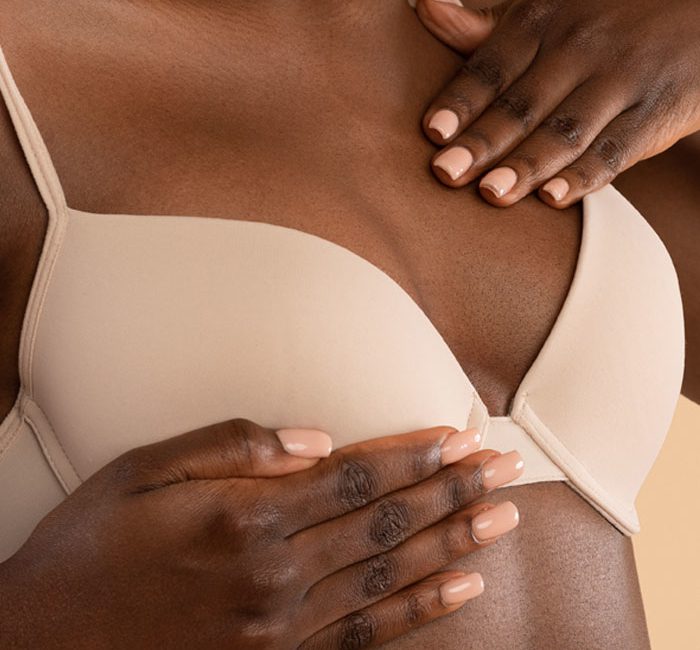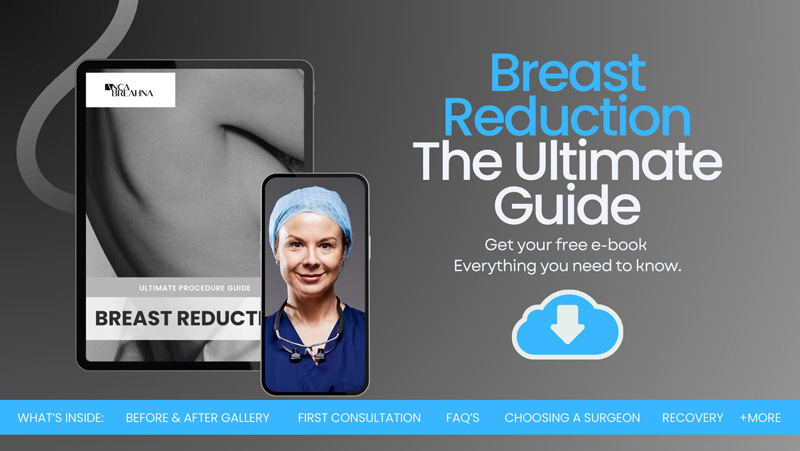Procedures
Nipple & Areola Reduction

What Is Nipple & Areola Reduction?
Nipple and areola reduction is often suited to men or women who are concerned that their nipples and / or areolas are larger or more prominent than they would like them to be. The procedure is tailored to the individual and addresses one or both of the nipples / areola. Large nipples can protrude more than is considered the norm and are more likely to be visible through t-shirts and tight-fitting tops. Particularly larger areola can also be wide in diameter, or can be puffy.
Reducing the appearance of the nipples / areola helps to restore a more natural appearance of the breast. In many cases large nipples and/ or areolae accompany other breast concerns, such as enlarged breasts. This procedure can be carried out in combination with other breast procedures such as breast reduction (for women) or gynaecomastia correction (for men) if this is necessary and you are deemed suitable, or as a stand-alone treatment option.
Download Miss Anca Breahna Breast Reduction Guide

At a glance
Approx. 60 minutes
Local anaesthetic
48 hours
Smaller nipples / areolae
Table of Contents
What is Nipple & Areola Reduction Surgery?
Nipple and areola reduction surgery is a cosmetic procedure aimed at altering the size and shape of the nipples and the areola (the darker skin surrounding the nipple) to achieve a more proportionate and aesthetically pleasing breast appearance. This surgical procedure can address concerns related to oversized nipples or areolas that may be congenital or result from hormonal changes, pregnancy, breastfeeding, or weight fluctuations. By adjusting the diameter and/or projection of the nipple and areola, this surgery can enhance the overall balance and symmetry of the breasts, contributing to improved self-esteem and comfort in one’s body.
Who Needs Nipple & Areola Reduction Surgery?
Nipple and areola reduction surgery is suitable for you if you are self-conscious or uncomfortable with the appearance of the nipples or areolas due to their size, shape, or asymmetry. Ideal candidates are those who:
- Feel that their nipples or areolas are disproportionately large compared to the rest of their breasts.
- Have experienced changes in nipple or areola size following pregnancy, breastfeeding, significant weight loss, or hormonal fluctuations.
- Suffer from physical discomfort or difficulty finding appropriate clothing or swimwear due to the size of their nipples or areolas.
- Are in good general health, have realistic expectations about the outcomes of the surgery, and are seeking improvement rather than perfection.
It is important for candidates to discuss their medical history, expectations, and any concerns with Consultant Plastic Surgeon Anca Breahna during the consultation to ensure the best possible outcomes.
Benefits of Nipple & Areola Reduction Surgery
The benefits of nipple and areola reduction surgery extend beyond the aesthetic enhancement of the breasts. This procedure offers several psychological and physical advantages, including:
- Improved Self-Confidence and Body Image: Many patients report a significant boost in self-esteem and body confidence following the surgery, as they feel more comfortable with the appearance of their breasts.
- Increased Comfort: Reducing the size of the nipples and areolas can alleviate physical discomfort experienced during physical activities or when wearing certain types of clothing or lingerie.
- Enhanced Symmetry and Proportion: The surgery can correct asymmetry between the nipples and areolas, achieving a more balanced and proportionate look that is in harmony with the rest of the breast and body.
- Expanded Clothing Options: Patients often find it easier to wear form-fitting clothes, swimwear, and low-cut tops without feeling self-conscious about the prominence of their nipples or areolas.
- Permanent Results: While the breasts can still undergo changes due to ageing, weight fluctuations, or hormonal factors, the results of nipple and areola reduction surgery are generally long-lasting, providing a permanent solution for those concerned about the size of their nipples or areolas.
Types of Nipple & Areola Reduction Surgery
Areola Reduction
This procedure targets the areola, reducing its diameter to achieve a size that is in better proportion with the nipple and the overall breast. Anca makes an incision around the perimeter of the areola, removing a circular strip of excess areolar tissue before suturing the remaining tissue back together. This technique can significantly improve the balance and symmetry of the breasts.
Nipple Reduction
Nipple reduction surgery aims to decrease the length and/or width of the nipple. There are several techniques for nipple reduction, including removing a portion of the nipple at its base to reduce projection or excising tissue from the sides of the nipple to decrease its width. The choice of technique depends on your anatomy and desired outcome.
Combined Nipple and Areola Reduction
Some patients may benefit from a combined approach that addresses both the nipple and the areola in a single procedure. This approach ensures that the nipple and areola are proportionate to each other and to the overall breast size, enhancing the aesthetic appearance of the breasts.
Nipple & Areola Reduction Surgery Explained
The process of nipple and areola reduction surgery begins with a detailed consultation with Consultant Plastic Surgeon Anca Breahna. During this consultation, you can discuss your aesthetic goals, and Anca will explain the surgical options, the procedure’s risks and benefits, and what to expect during recovery.
The Procedure
On the day of surgery, markings will be made on the nipples and areolas to guide the incisions. The surgery is performed under local anaesthesia with sedation, ensuring your comfort throughout the procedure. The specific technique used will depend on the individual’s needs and the type of reduction being performed.
For areola reduction, a circular incision is made around the areola, and a donut-shaped piece of tissue is removed. The skin is then brought together and sutured, reducing the overall diameter of the areola. For nipple reduction, the excess tissue is either removed from the tip of the nipple to reduce its height or from the sides to decrease its width. The incisions are then closed with fine sutures to minimise scarring.
Nipple and areola reduction surgery can be customised to meet the unique needs and aesthetic goals of each patient. The procedure typically focuses on reducing the size of the areola, the nipple, or both, and can be performed using various techniques, depending on the specific concerns being addressed. Each type of surgery is performed under local anaesthesia, often with sedation, and can take between 1 to 2 hours, depending on the complexity of the procedure and whether both breasts are being treated.
Recovery and Aftercare
Recovery from nipple and areola reduction surgery is relatively quick, with most patients able to return to work and normal activities within a few days to a week. However, strenuous activities and heavy lifting should be avoided for at least 2-3 weeks to allow for proper healing.
You may experience some swelling, bruising, and discomfort in the days following the surgery, which can be managed with prescribed pain medication. It’s important to follow all aftercare instructions provided by Anca, including wearing a supportive bra, keeping the surgical area clean, and attending follow-up appointments to monitor healing.
Reviews
Patient satisfaction is the top priority for Anca. You can find how patients feel about her work below.
Breast Augmentation with Areola Reduction: Expert Care, Natural Result
From day 1, I knew Miss Breahna was a surgeon I could trust. I received the utmost care and attention before, during and after the procedure. She made certain that I was aware of all the risks and managed my expectations in a professional manner. I opted for a breast augmentation with areola reduction, which comes with a greater likelihood of scar spreading.
A talented surgeon with a personal touch, Miss Breahna ensured I was well looked after the entire time. I’m delighted with the results – my new breasts look super natural and have given me the boost in confidence I needed after having 3 children. My scarring is now barely visible and my overall healing has been much smoother than I expected. Thank you Anca, 5 stars from me all the way!

Miss Breahna was incredible! I went to her for a breast reduction surgery and she was so caring and understanding and did such a wonderful job. I felt really listened to over what I wanted and very well informed. I’m so pleased with the results, it’s genuinely been a life changing surgery for me. Her secretary was also amazing and made it really easy to reach Miss Breahna with any questions or concerns I had. I’d highly recommend!
Pricing & Funding for Nipple and Areola Reduction Surgery in UK
The cost of nipple and areola reduction surgery in the UK is influenced by various factors, including the surgeon’s expertise, the complexity of the procedure, and the location of the clinic. On average, prices can range from £2,000 to £5,000. This fee covers the surgeon’s charges, anaesthesia, the use of the surgical facility, and follow-up care. It’s important to note that prices can vary significantly, and it’s advisable to obtain detailed quotations from several reputable surgeons to understand the full scope of the costs involved.
Private Health Insurance and NHS Coverage
In most cases, nipple and areola reduction surgery is considered a cosmetic procedure, meaning it is not usually covered by the NHS or private health insurance. However, exceptions may be made if the surgery is deemed medically necessary due to physical discomfort or psychological distress. Patients should consult their insurance to discuss their individual circumstances and explore potential coverage options.
Financing and Payment Plans
Some clinics offer financing options or payment plans to help make the surgery more affordable. These plans can spread the cost of the procedure over several months or years, making it easier to manage financially. It’s essential to carefully review the terms of any financing agreement and consider the total amount payable, including any interest or charges, before committing to a plan.
Further Reading
- Read Anca’s Blog on How to Fix Inverted Nipples

Procedure
Frequently asked questions
Am I suitable for nipple and areola reduction?
Chester Cosmetic Surgery will carry out a full and thorough examination of your nipples and areola before recommending this procedure. You may be suitable if you are in generally good health, do not smoke, are not pregnant or breastfeeding and are presenting with enlarged / prominent nipples and / or areola (the dark skin that surrounds the nipple).
Is this procedure safe?
The techniques Miss Breahna uses in her surgical breast procedures is safe for patients to undergo, if they are deemed suitable for surgery.
Will this procedure hurt?
The nipples and areola are an especially sensitive part of the body, and often respond to touch. For this reason, cutting into the skin on this area can be painful and uncomfortable. Chester Cosmetic Surgery considers local anaesthetic a suitable method of pain relief as it will completely numb the treatment area so patients will not feel any pain.
Are there any side effects or risks?
An incision in the skin will cause the tissues some trauma, albeit controlled. In response the area will become swollen and bruised for a couple of weeks, and may be open to infection. Miss Breahna will provide excellent aftercare advice to help patients manage the after effects of surgery, and recover well.
When will I see the results?
A period of 12 weeks may need to be allowed before the full results can be seen.
What are the risks associated with nipple and areola reduction surgery?
As with any surgical procedure, there are risks involved, including infection, bleeding, scarring, changes in nipple sensation, and dissatisfaction with the aesthetic outcome. Choosing a qualified and experienced surgeon can help minimise these risks.
Will there be scars?
Scarring is inevitable with any surgery, but the incisions for nipple and areola reduction are typically small and strategically placed to be as inconspicuous as possible. Over time, scars usually fade and become less noticeable.
Are there alternatives to surgery?
Non-surgical alternatives are limited for reducing the size of the nipples and areolas. Some patients may find temporary solutions with specific bras or clothing, but these do not offer permanent changes.
What if I choose not to have the surgery?
Choosing not to have surgery is a personal decision. While there are no health risks associated with not undergoing nipple and areola reduction, you may continue to experience psychological discomfort or self-consciousness about your appearance.
What causes enlarged nipples or areolas?
Enlarged nipples or areolas can be caused by genetics, hormonal changes, pregnancy, breastfeeding, and significant weight fluctuations. In many cases, they are a natural variation of the human body.
Is the surgery painful?
Patients usually experience minimal pain during the procedure due to local anaesthesia and possibly sedation. Post-operative discomfort is often mild and can be managed with prescribed pain medication.
Will the results of the surgery change if I get pregnant?
Pregnancy and breastfeeding can alter the size and shape of the breasts, potentially affecting the results of the surgery. It’s advisable to discuss future pregnancy plans with Anca during the consultation.
How can I prepare for the procedure?
Preparation for nipple and areola reduction surgery may include undergoing a medical evaluation, adjusting current medications, avoiding aspirin and certain anti-inflammatory drugs, and stopping smoking. Anca will provide detailed instructions based on your specific situation.
When will I see the results?
While initial improvements may be noticeable immediately after surgery, the final results typically emerge once the swelling and bruising subside, which can take several weeks. Full healing and the maturation of scars may take several months to a year.
Can the size of the nipples or areolas increase again after surgery?
The results of nipple and areola reduction surgery are generally permanent. However, hormonal changes, pregnancy, and weight gain can potentially affect the size and shape of the nipples and areolas over time.






